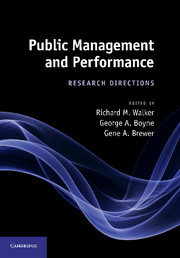Book contents
- Frontmatter
- Contents
- List of figures
- List of tables
- Notes on contributors
- 1 Introduction
- 2 Extending goal ambiguity research in government: from organizational goal ambiguity to programme goal ambiguity
- 3 Budgets and financial management
- 4 Organizational structure and public service performance
- 5 Red tape: the bane of public organizations?
- 6 Managerial networking, managing the environment, and programme performance: a summary of findings and an agenda
- 7 Public service motivation and performance
- 8 Organizational diversity and public service performance
- 9 Performance management: does it work?
- 10 Strategy: which strategic stances matter?
- 11 Methods
- 12 Conclusion: enriching the field
- Index
- References
8 - Organizational diversity and public service performance
Published online by Cambridge University Press: 05 July 2014
- Frontmatter
- Contents
- List of figures
- List of tables
- Notes on contributors
- 1 Introduction
- 2 Extending goal ambiguity research in government: from organizational goal ambiguity to programme goal ambiguity
- 3 Budgets and financial management
- 4 Organizational structure and public service performance
- 5 Red tape: the bane of public organizations?
- 6 Managerial networking, managing the environment, and programme performance: a summary of findings and an agenda
- 7 Public service motivation and performance
- 8 Organizational diversity and public service performance
- 9 Performance management: does it work?
- 10 Strategy: which strategic stances matter?
- 11 Methods
- 12 Conclusion: enriching the field
- Index
- References
Summary
Introduction
Public organizations in developed countries are becoming more and more diverse, particularly along racial, ethnic and gender lines. Globalization, technology, and shifting cultural norms have contributed to increased percentages of women and people of colour in the workforce worldwide. In European countries, EU guidelines on immigration have led to marked increases in the numbers of foreign nationals living in many member countries (OECD 2003). The workforces of countries formerly under apartheid rule, such as Namibia and South Africa, are seeing fast, significant increases in the representation of ethnic minorities (Balogun 2001). In the United States growing immigration has led to sharp increases in non-native-English-speaking residents (Rubaii-Barrett and Wise 2007). This surge in workforce diversity has created challenges for public managers who are accustomed to managing in a homogeneous environment. Diversity provides both opportunities and struggles for organizations with shifting demographic profiles, but research on managing diversity is still in its infancy. As this literature develops, it is becoming clear that employee diversity creates implications for both the sociology of organizations and the human resources management strategies that best address employee differences. These two lenses – one behavioural, one managerial – have provided the foundation for much of the work on organizational diversity and its consequences for performance.
- Type
- Chapter
- Information
- Public Management and PerformanceResearch Directions, pp. 178 - 206Publisher: Cambridge University PressPrint publication year: 2010
References
- 7
- Cited by



